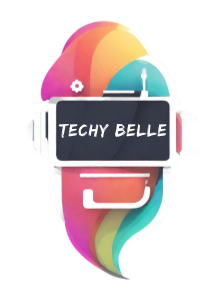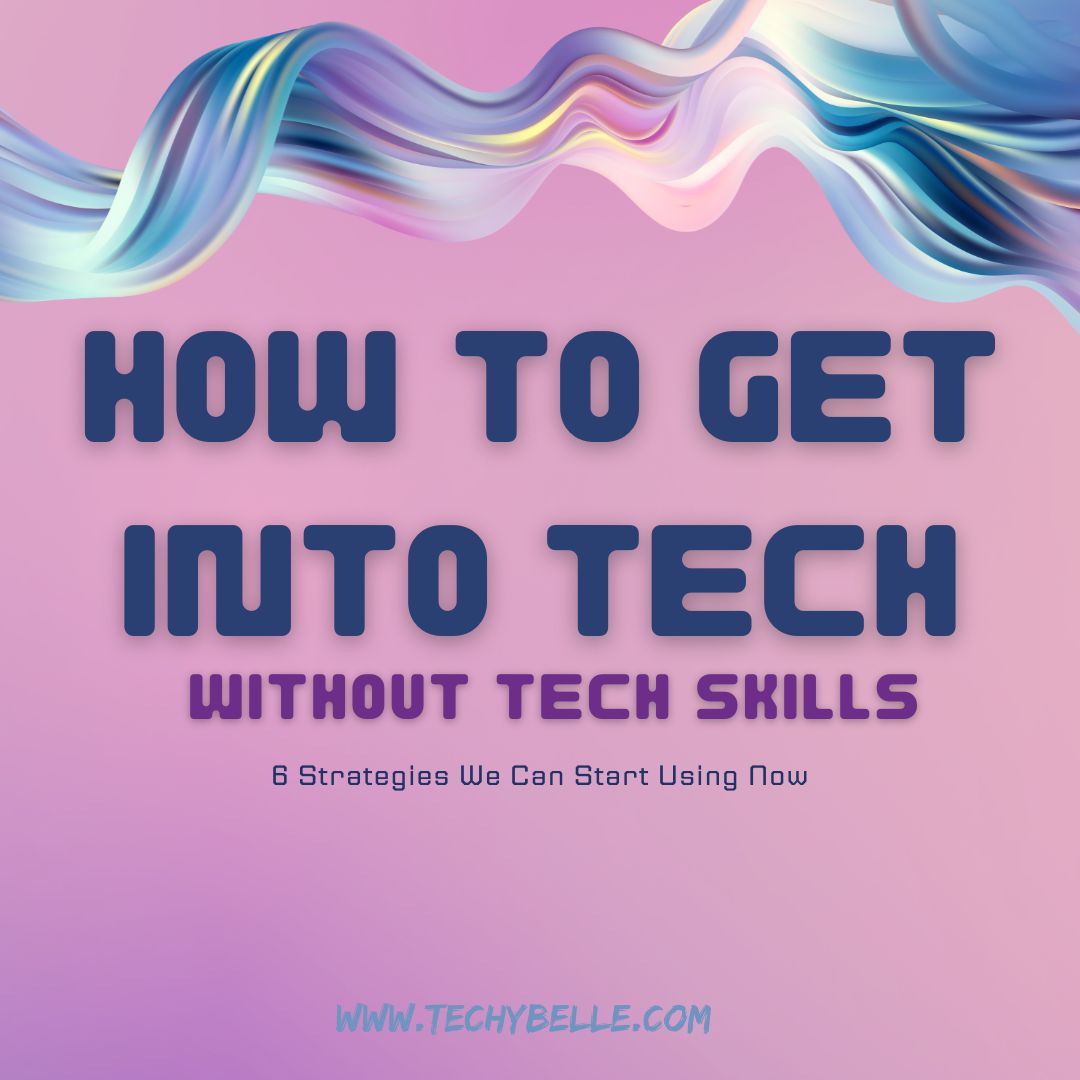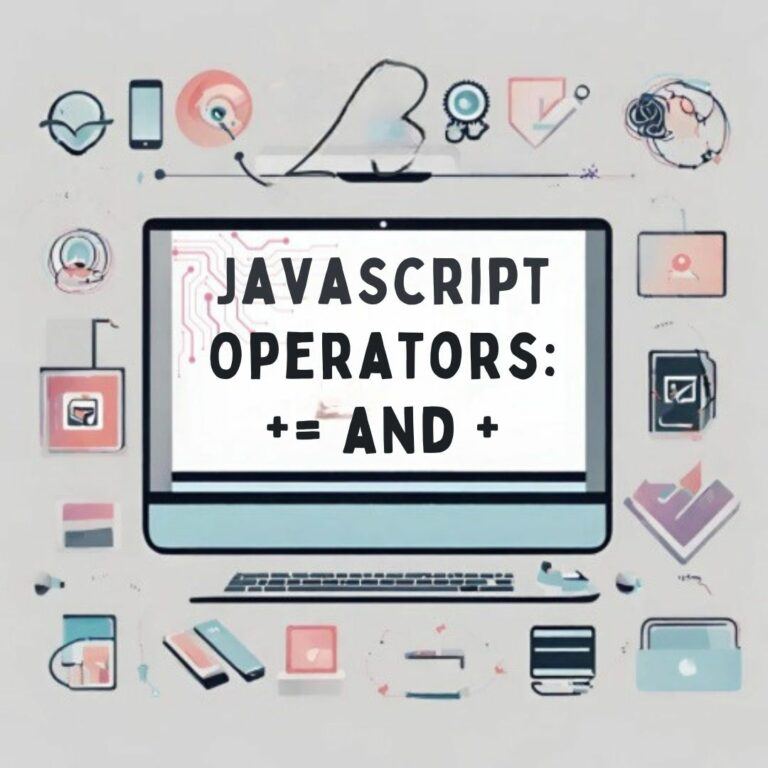How To Get Into Tech: 6 Strategies We Can Use To Triumphantly Enter Tech Without Tech Skills
Hey there, lovely readers! ? Just a heads-up, some of the links in this post are affiliate links. That means if you click on them and make a purchase, I may earn a small commission at no extra cost to you. Your support helps keep this blog running and allows me to provide you with valuable content. I only recommend products or services that I truly believe in. Thanks for being amazing and supporting my work!” ??
Hey there, Techy Belles! Today I’ve got something special for those of you eyeing the tech world but feeling a bit overwhelmed by the sea of code and complex jargon. Guess what? You can totally dive into the tech realm even if you’re not packing a ton of tech skills, yet. Intrigued? Let’s unlock that door together!
How to Get Into Tech (without tech skills)

So, you’ve heard about the booming opportunities in tech, but the idea of needing hardcore tech skills might be holding you back. Well, fret not! In this journey, we’ll explore how to navigate the tech landscape without necessarily having a computer science degree.
1. Assessing Our Current Skills
Transferable Skills Are Your Superpower
First things first, let’s take stock of your current skills. Believe it or not, many non-tech skills are absolute gold in the tech industry. Communication, problem-solving, and creativity? Check, check, and check.
Examples of Non-Tech Skills That Matter
Think about your project management skills, your knack for creativity, or your ability to dissect and solve problems. These are your tickets to the tech show.
1. Self-Reflection on Transferable Skills
Before you even think about coding or algorithms, take a moment for some self-reflection. What skills have you honed in your current or past roles? Project management, communication, problem-solving, creativity – these are your transferable skills, and they’re gold in the tech industry.
- Example: If you’ve coordinated a marketing campaign, you’ve likely managed timelines, communicated with various stakeholders, and problem-solved when unexpected issues popped up. These skills are incredibly valuable in tech project management.
2. Identifying Skills Relevant to the Tech Industry
Now, let’s align your existing skills with what the tech industry craves. Strong communicators make excellent technical writers or community managers. Creative thinkers might find a home in UX/UI design. The idea is to bridge what you already bring to the table with what tech companies are hungry for.
- Example: Your knack for creative problem-solving in a non-tech context can be applied to brainstorming innovative solutions to tech-related challenges.
3. Examples of Non-Tech Skills Valued in Tech Roles
Let’s break down some examples of non-tech skills that can make you stand out in various tech roles:
- Communication: Essential for project management, client relations, or even tech writing.
- Problem-Solving: A core skill in debugging and troubleshooting, whether you’re a coder or not.
- Creativity: Vital for UX/UI design, content creation, and innovative problem-solving.
- Attention to Detail: Critical for quality assurance, ensuring products and processes meet high standards.
- Example: Your strong communication skills might be the key to translating complex technical jargon into language that clients or team members can easily understand.
4. Real Stories: Non-Techies Who Nailed It
To truly drive the point home, let’s explore real stories of individuals who successfully made the leap into tech without a traditional tech background. These stories showcase the diverse paths people took, emphasizing that your unique journey is not only valid but also potentially groundbreaking.
- Example: Meet Jane, a former teacher turned tech project manager. Her organizational and communication skills from the classroom seamlessly translated into managing complex tech projects, proving that teaching and tech can go hand in hand.
- My Personal Experience: Despite initially deeming tech too challenging, my journey took an unexpected turn when a former co-worker saw potential in my SQL knowledge. After years of reluctance and various tech courses, including an incomplete coding BootCamp, I finally embraced an opportunity, realizing that the coveted “tech skills” weren’t as crucial as my project management abilities and eagerness to learn, ultimately securing the job. This experience highlighted the value of unconventional paths in the tech industry.
In essence, assessing your current skills is about recognizing the value you bring to the tech table beyond coding languages. It’s about understanding that the tech world needs a diverse set of skills, and yours might be the missing piece in a tech puzzle waiting to be solved. Embrace your strengths, and let’s move on to the next steps in your tech journey!
2. Understanding the Tech Landscape

Tech Domains: More Than Just Coding
Tech isn’t just about coding. There’s a vast landscape with roles like project management, UX/UI design, and even marketing. Dive into different domains to find where your non-tech skills can shine.
1. Navigating the Vast Domains of Tech
The tech landscape is a vast terrain, and it’s crucial to recognize that it’s not just about coding. Dive into different domains such as project management, UX/UI design, cybersecurity, and more. Understanding the breadth of opportunities allows you to identify areas where your unique skills can make a significant impact.
- Example: If you have a background in marketing, your skills might align well with roles in digital marketing for tech products or even user experience research.
2. Exploring Roles Beyond Traditional Tech Backgrounds
Tech isn’t reserved for those with computer science degrees. Many successful professionals entered the tech world from diverse backgrounds. Discovering these stories can be not only inspiring but also eye-opening, showcasing that there are multiple entry points into the tech industry.
- Example: Someone with a psychology background might find their niche in user experience (UX) design, focusing on creating tech products that resonate with human behavior.
3. Real Stories: Breaking the Mold
Real stories of individuals who navigated the tech landscape without traditional tech backgrounds can provide valuable insights. Whether it’s a linguist turned data analyst or an artist excelling in UX design, these narratives emphasize that diversity of skills and perspectives is highly valued in the tech world.
- Example: Meet Alex, a former graphic designer who transitioned seamlessly into UI design, bringing a fresh and artistic approach to creating visually appealing and user-friendly interfaces.
Understanding the tech landscape involves not only recognizing the various domains but also acknowledging that diversity in skills and backgrounds is a strength, not a limitation. Embrace the breadth of opportunities available, and you’ll find that the tech industry is a dynamic and inclusive space ready to welcome your unique contributions.
Tech Basics: GeekPack Collective
Feeling a bit lost in the tech jungle? No worries. With GeekPack you can start with the basics. From understanding key concepts to navigating online courses, you’ll be a tech whiz in no time.
Online Courses and Resources: Don’t Tech Alone
Trust me; there are tons of beginner-friendly courses out there waiting for you. There are also amazing tech communities on and offline filled with people who will show you how to get into tech.
3. Showcasing Our Skills: Crafting Our Tech Narrative

1. Building a Resume that Speaks Tech and You
Creating a tech-centric resume is an art. Highlight your transferable skills prominently, emphasizing how they align with the tech roles you’re eyeing. Showcase your achievements and experiences in a way that demonstrates your unique contributions, even if you haven’t been knee-deep in code.
- Example: If you’re transitioning from marketing, emphasize successful campaign launches, highlighting your ability to analyze data and drive results—skills that are invaluable in many tech roles.
2. Online Presence: Your Digital Tech Persona
In the digital age, your online presence is as crucial as your resume. Optimize your LinkedIn profile with a professional photo, a compelling headline, and a well-crafted summary that reflects your journey into tech. Share articles, insights, and projects to showcase your genuine interest and growing expertise.
- Example: Regularly post about your tech learning journey, share relevant articles, and engage with the tech community to establish yourself as an enthusiastic learner and contributor.
- Start a Tech Journey Blog: Starting a tech journey blog offers the invaluable benefit of documenting your learning process, connecting with a community of like-minded individuals, and creating a resource that not only tracks your growth but also serves as inspiration and guidance for others venturing into the dynamic world of technology.
3. Developing a Tech-Focused Portfolio
Even if you’re not a seasoned coder, a portfolio is a powerful tool. Include projects that highlight your problem-solving abilities, project management skills, and any hands-on tech experience you’ve gained. This tangible evidence of your capabilities can speak louder than a list of skills on a resume.
- Example: If you streamlined a process in your previous role, create a case study showcasing the problem, your solution, and the positive outcomes. This demonstrates your ability to bring tangible improvements, a skill highly valued in tech.
4. Networking with Purpose
Networking is not just about collecting business cards; it’s about cultivating meaningful connections. Attend tech events, join online communities, and participate in discussions. Leverage your interpersonal skills to connect with professionals in the field, showcasing not just what you know but who you are.
- Example: Engage in conversations about the intersection of tech and your previous industry, showcasing a unique perspective and the value you bring to the tech table.
5. Stay Adaptable: Embracing Continuous Learning
In the ever-evolving tech landscape, showcasing your skills isn’t a one-time task. Demonstrate your commitment to growth by staying adaptable. Highlight any additional courses, certifications, or new skills you’ve acquired. This not only reinforces your existing skills but shows potential employers that you’re dedicated to staying current.
- Example: Include a section in your resume or LinkedIn profile dedicated to ongoing education, showcasing your commitment to continuous learning and improvement.
Remember, showcasing your skills is about telling a compelling story about your journey into tech. It’s not just about what you’ve done; it’s about the potential you bring to the rapidly evolving tech industry. Craft your narrative thoughtfully, and let your skills shine in a way that’s authentic to you.
4. Leveraging Tech Resources: Navigating the Tools of the Trade

1. Unveiling Essential Tech Tools
In the vast landscape of technology, numerous tools can simplify processes and enhance productivity. Whether you’re exploring project management, design, or coding, identifying and utilizing the right tools is key. From collaboration platforms to coding environments, discover the essential tech tools that align with your journey.
- Example: As a project manager, tools like Trello or Asana can streamline task management, while platforms like GitHub offer insights into version control, even if you’re not deep into coding.
2. Staying Informed: Navigating Tech Trends
Staying abreast of tech trends is crucial for anyone entering the industry. Leverage resources like tech blogs, podcasts, and online communities to immerse yourself in discussions about emerging technologies, industry updates, and innovative practices. This not only broadens your knowledge but helps you make informed decisions about your learning path.
- Example: Following influential tech blogs or subscribing to podcasts can keep you informed about advancements in areas like artificial intelligence, cybersecurity, or user experience design.
3. Online Learning Platforms: Your Continuous Classroom
Embrace the wealth of knowledge offered by online learning platforms. From established platforms like Coursera and edX to specialized ones like Codecademy or UX Design Institute, these platforms provide structured courses taught by industry professionals. Leverage these resources to build a solid foundation and advance your skills in specific areas of interest.
- Example: If you’re keen on diving into coding, platforms like freeCodeCamp or Udacity offer interactive courses that guide you through real-world projects.
4. Networking Opportunities: Virtually Connecting with the Tech Community
Technology has made networking more accessible than ever. Join tech communities on social media, attend virtual meetups, and participate in forums relevant to your interests. Engaging with seasoned professionals and fellow learners provides insights, support, and opportunities you might not find elsewhere.
- Example: Platforms like LinkedIn or Twitter are not just for job hunting; they’re vibrant spaces where professionals share insights, ask questions, and foster connections. Engage thoughtfully to build your presence.
5. Mentorship: Learning from Those Who’ve Walked the Path
Seeking mentorship is a powerful way to accelerate your tech journey. Connect with individuals who have experience in your desired field, learn from their insights, and gain valuable guidance. Mentorship offers a personalized learning experience and helps you navigate challenges with the wisdom of someone who’s been there before.
- Example: Reach out to professionals in your network or through online platforms offering mentorship programs. Their advice and encouragement can be instrumental in your growth.
Leveraging tech resources is not just about using tools; it’s about creating a strategic approach to your learning journey. By incorporating these resources into your routine, you’re not only staying current but actively shaping your path in the ever-evolving tech landscape.
5. Networking and Mentorship: Forging Connections in the Tech Sphere

1. Building a Network: Your Professional Safety Net
Networking in the tech industry is more than just exchanging business cards; it’s about cultivating a community of professionals who can offer support, guidance, and opportunities. Attend tech events, both virtual and in-person, to connect with like-minded individuals. Join online forums and communities where discussions range from industry trends to problem-solving.
- Example: Regularly engage in conversations on platforms like Dev.to and even TikTok, showcasing your expertise and curiosity, and you might find yourself building connections with professionals who share your interests.
2. LinkedIn: Your Digital Business Card
LinkedIn isn’t just an online resume; it’s a powerful tool for networking. Optimize your profile with a professional photo, a compelling headline, and a well-crafted summary. Connect with professionals you admire, and don’t hesitate to reach out with personalized messages expressing your interest in their work or seeking advice.
- Example: Engage in industry-specific LinkedIn groups, share your insights, and connect with professionals to expand your network. Meaningful interactions can lead to valuable connections.
3. Attending Meetups and Conferences: Where Connections Flourish
Whether in-person or virtual, attending tech meetups and conferences provides opportunities to meet industry experts, potential mentors, and fellow enthusiasts. Participate in Q&A sessions, join breakout discussions, and don’t be shy about introducing yourself. These events are often treasure troves for networking.
- Example: Explore platforms like Meetup or Eventbrite to discover local or virtual tech events. Attend with an open mind, ready to absorb knowledge and forge connections.
4. Mentorship: Guiding Lights in Your Tech Journey
Seeking mentorship is akin to having a seasoned guide on your tech adventure. A mentor can provide valuable insights, share experiences, and offer personalized advice tailored to your goals. Look for mentors who align with your aspirations, and don’t be afraid to reach out with a well-thought-out request.
- Example: If you’re transitioning from a non-tech background, seek a mentor who made a similar journey. Their firsthand experience can offer guidance on overcoming challenges and making the most of your unique skill set.
- Women In Tech Global Mentoring Program: The Women in Tech Global Mentorship Experience is an empowering initiative that facilitates meaningful connections between aspiring women in tech and accomplished mentors worldwide, fostering a supportive environment for skill development, career guidance, and the cultivation of a diverse and inclusive tech community.
5. Giving Back: The Two-Way Street of Networking
Remember, networking is a two-way street. Offer your assistance, insights, or support to others in your network. Being a valuable contributor makes you memorable and strengthens your connections. Share your knowledge, celebrate others’ achievements, and actively contribute to the tech community.
- Example: If you come across a question in a forum that aligns with your expertise, take the time to provide a thoughtful answer. Your willingness to help can enhance your reputation within the community.
Networking and mentorship are not just about accumulating contacts; they’re about fostering genuine relationships. Embrace the collaborative spirit of the tech community, and you’ll find that these connections become pillars of support, guiding you through the challenges and triumphs of your tech journey.
6. Overcoming Challenges: Navigating the Bumps in Our Tech Journey

1. Imposter Syndrome: Embracing Your Worth
Imposter syndrome is a common companion in the tech world, but acknowledging your achievements, no matter how small, is the first step in overcoming it. Remember, you bring unique perspectives and skills to the table, making your journey an asset rather than a hindrance.
- Example: If you catch yourself feeling like you don’t belong, take a moment to reflect on your accomplishments, both in and outside of tech. Recognizing your strengths helps silence the inner critic.
2. Navigating Tech-Specific Challenges
Tech comes with its set of challenges, from learning new languages to facing complex problem-solving. Break down these challenges into smaller, manageable goals. Seek support from online communities, mentors, or colleagues who’ve been through similar challenges, turning each obstacle into a learning opportunity.
- Example: If coding seems overwhelming, focus on mastering one concept at a time. Collaborate with peers, seek guidance from mentors, and celebrate the small victories along the way.
3. Continuous Learning: Embracing the Tech Marathon
The tech landscape evolves rapidly, and the pressure to stay updated can be daunting. Instead of seeing it as a race, view it as a marathon. Establish a consistent learning routine, prioritize topics aligned with your goals, and embrace the mindset that learning is a lifelong journey.
- Example: Allocate dedicated time each week for learning, explore topics that genuinely interest you, and view each new skill acquired as a step forward, regardless of the pace.
4. Realistic Expectations: Setting Yourself Up for Success
Setting realistic expectations is vital. Understand that setbacks are part of the learning process. Celebrate your successes, learn from failures, and recognize that progress may not always be linear. Patience and persistence are key components of a successful tech journey.
- Example: If a coding project takes longer than anticipated, don’t be discouraged. Reflect on the challenges, seek feedback, and consider it a valuable lesson for future endeavors.
5. Leveraging Support Systems: Your Tech Tribe
Navigating challenges is easier when you have a support system. Engage with your tech community, share your experiences, and seek advice when needed. Whether through online forums, mentorship programs, or local meetups, a supportive network can provide valuable insights and encouragement.
- Example: If you’re feeling stuck on a particular problem, don’t hesitate to reach out to your network. Someone might offer a fresh perspective or share their own experience overcoming a similar hurdle.
Overcoming challenges in your tech journey is not about avoiding them but navigating them with resilience and a growth mindset. Embrace the process, learn from each experience, and remember that the challenges you face today are shaping the capable tech professional you’re becoming.
Conclusion

And there you have it, my tech-savvy pals! Getting into tech without a tech background is not only possible but also exciting. Remember, it’s about the journey, the learning, and the growth. So, go ahead, unlock that tech door, and step into a world of endless possibilities.
I hope this will be your go-to tech companion. Share your thoughts, stories, or questions below, and let’s keep this conversation going. Here’s to your tech adventure! ?








You covered a lot of information. Thanks! What is SQL?
Thank you for checking out my post! It was a lot of information, but hopefully it gave you some inspiration about starting in tech. SQL means Structured Query Language. It’s use for navigating databases. I have post that provides more information, if you’re interested:https://techybelle.com/where-can-i-learn-sql/